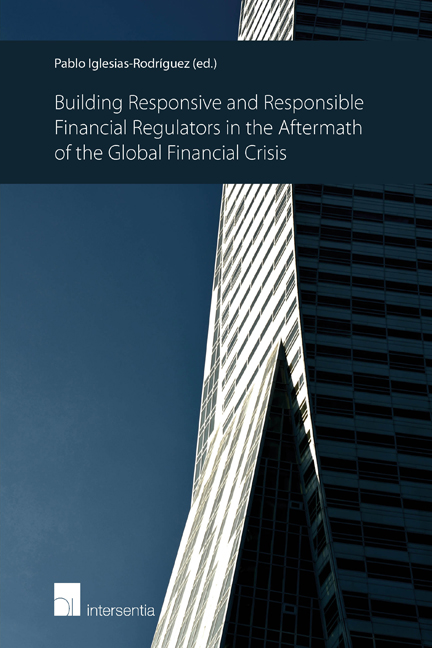Book contents
- Frontmatter
- Preface and acknowledgements
- Foreword
- Contents
- List of contributors
- Responsive-and-responsible financial regulation in the aftermath of the global financial crisis
- Part I THE CONTRIBUTION OF ACCOUNTABILITY, INDEPENDENCE AND ECONOMIC THEORY TO RESPONSIVE-AND-RESPONSIBLE FINANCIAL REGULATION
- Part II POST-CRISIS ARCHITECTURES OF FINANCIAL REGULATION IN THE EUROPEAN UNION, THE UNITED STATES OF AMERICA AND CANADA: ACCOUNTABILITY AND RESPONSIVENESSAND- RESPONSIBILITY
- Part II. 1 THE EUROPEAN UNION
- Part II. 2 THE UNITED STATES OF AMERICA
- Part II. 3 CANADA
Why opacity is just not good enough: the effectiveness and accountability of Canada's Office of the Superintendent of Financial Institutions
from Part II. 3 - CANADA
Published online by Cambridge University Press: 26 November 2017
- Frontmatter
- Preface and acknowledgements
- Foreword
- Contents
- List of contributors
- Responsive-and-responsible financial regulation in the aftermath of the global financial crisis
- Part I THE CONTRIBUTION OF ACCOUNTABILITY, INDEPENDENCE AND ECONOMIC THEORY TO RESPONSIVE-AND-RESPONSIBLE FINANCIAL REGULATION
- Part II POST-CRISIS ARCHITECTURES OF FINANCIAL REGULATION IN THE EUROPEAN UNION, THE UNITED STATES OF AMERICA AND CANADA: ACCOUNTABILITY AND RESPONSIVENESSAND- RESPONSIBILITY
- Part II. 1 THE EUROPEAN UNION
- Part II. 2 THE UNITED STATES OF AMERICA
- Part II. 3 CANADA
Summary
This chapter considers the effectiveness and the accountability of financial services sector regulators by focusing on the Office of the Superintendent of Financial Institutions (OSFI), Canada's prudential regulator. We identify three broad measures of effectiveness – the overall regulatory framework, outcome, and adaptability – and, three measures of accountability – vertical accountability, the co-production of accountability, and the culture and value placed on being accountable. In the aftermath of the 2007–2008 global financial crisis, OSFI has been hailed as a very effective regulator. We argue, however, that OSFI's performance should be more critically assessed; there is a need, in particular, for greater transparency. This chapter pays particular attention to the difficult balancing act between opacity and transparency in financial services sector regulation.
The 2007–2008 global financial crisis highlighted anew the importance of a properly functioning financial system for the economy, and of good, effective and accountable supervision and regulation. The crisis was the result of both market failures, and political, legislative and regulatory failures. This chapter is specifically interested in the effectiveness and accountability of financial services sector regulators, and how to assess performance. As part of this discussion, we are particularly attentive to the relationship, and difficult balancing act, between opacity and transparency. Effectiveness is, in a way, closely associated with opacity; regulators can be more flexible in an opaque environment, at the same time, opacity makes it difficult to assess performance. Transparency, on the other hand, can impede effectiveness, though it also likely increases accountability. In this chapter, we consider the effectiveness and accountability of financial services sector regulators by studying the Office of the Superintendent of Financial Institutions (OSFI), Canada's prudential regulator.
How effective and accountable is OSFI? How does OSFI fulfill its mandate and stated objectives? How does it operate in practice? What are its accountability mechanisms? Following the 2007–2008 global financial crisis, OSFI has been frequently commended for its role in helping the country navigate through the crisis. The IMF has been positive about Canadian supervision and regulation of financial markets. Anand and Green suggest that OSFI has shown itself to be a very effective regulator.
- Type
- Chapter
- Information
- Building Responsive and Responsible Financial Regulators in the Aftermath of the Global Financial Crisis , pp. 255 - 273Publisher: IntersentiaPrint publication year: 2015

